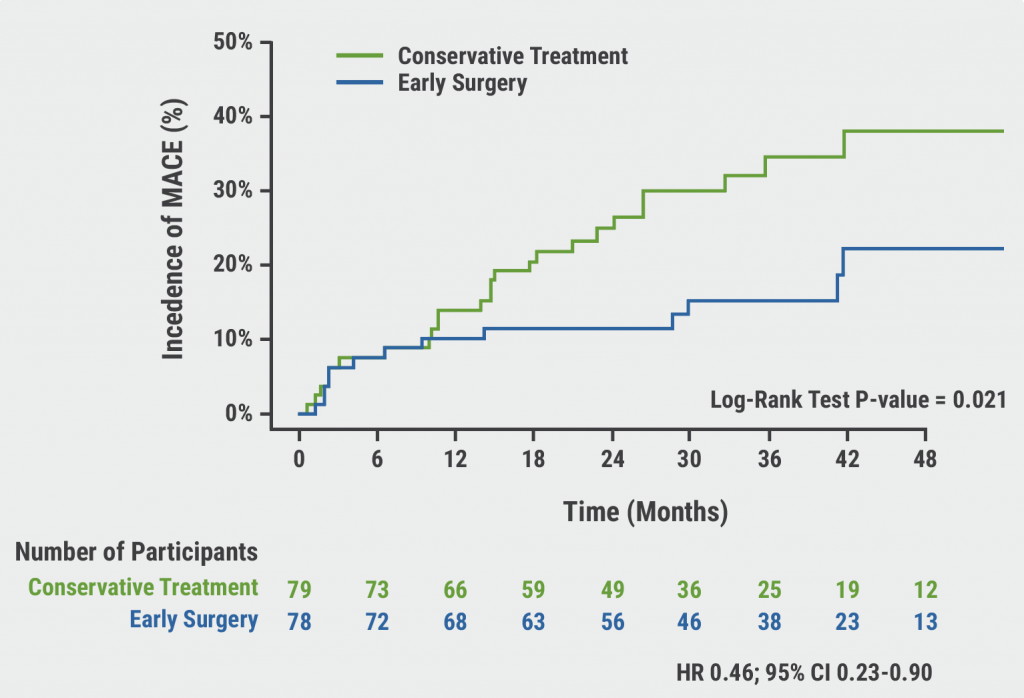The randomised, phase 3 REDUCE-IT trial (NCT01492361) was conducted to investigate the safety and efficacy of icosapent ethyl in patients at high risk for cardiovascular events [2]. For the primary analysis, 8,179 patients who were treated with statins were randomised 1:1 to 4 g icosapent ethyl once daily or placebo. After approximately 5 years of follow-up, a relative risk reduction in cardiovascular events of 24.8% was observed in participants receiving icosapent ethyl compared with those receiving placebo. The current subgroup analysis, presented by Dr Deepak Bhatt (Brigham and Women’s Hospital, Boston, MA, USA), examined whether this benefit extends to patients with prior PAD (n=688).
The subpopulation of patients with prior PAD was demonstrated to be a very high-risk cohort in the REDUCE-IT study: 41.7% of the patients with PAD showed a first ischaemic cardiovascular event in the 5-year follow-up period versus 31.1% of the patients with atherosclerosis but without PAD (P=0.0004). The cumulative event rate was 98.2% in patients with PAD versus 61.4% in patients without prior PAD (P<0.0001).
The risk reduction of icosapent ethyl on total cardiovascular events in patients with prior PAD after approximately 5 years of follow-up was 32% (P=0.03) and displayed a non-significant 22% risk reduction in first cardiovascular events (P=0.08). A similar effect was observed in patients with atherosclerosis but without PAD.
The safety profile of icosapent ethyl in patients with PAD was consistent with the overall trial population. Tolerability and adverse events of placebo receivers and icosapent ethyl receivers were mostly comparable. Atrial fibrillation was reported numerically more frequently in the icosapent ethyl arm (5.2%) than in the placebo arm (2.6%; P=0.07). No differences in bleeding were found. However, Dr Bhatt added that this last finding could be related to the limited sample size of the PAD subpopulation.
In conclusion, icosapent ethyl provided significant risk reduction in cardiovascular events in the very high-risk subpopulation of patients with prior PAD of the REDUCE-IT trial. The effect sizes were similar to the overall trial results.
- Bhatt DL, et al. Benefits of Icosapent Ethyl in Patients with Prior Peripheral Artery Disease: REDUCE-IT PAD. VA.RFO.19, AHA 2021 Scientific Sessions, 13–15 November.
- Bhatt DL, et al. N Engl J Med 2019;380:11–22.
Copyright ©2021 Medicom Medical Publishers
Posted on
Previous Article
« Ticagrelor cessation: early CABG non-inferior to delayed surgery Next Article
Deficient treatment outcomes after PVI in Black and low-income adults with PAD »
« Ticagrelor cessation: early CABG non-inferior to delayed surgery Next Article
Deficient treatment outcomes after PVI in Black and low-income adults with PAD »
Table of Contents: AHA 2021
Featured articles
The scope of remote healthcare in hypertension and hyperlipidaemia
Atrial Fibrillation
New developments in remote diagnostics and monitoring of AF
Head-to-head: Efficacy of dabigatran versus warfarin on cognitive impairment
Posterior left pericardiotomy safe and effective in reducing atrial fibrillation
LAA ligation did not reduce recurrent atrial arrhythmias in persistent AF
Equal benefits of early rhythm control in AF subtypes
CVD Risk Reduction
Remote healthcare programme improves hypertension and lipid control
Novel oral PCSK9 inhibitor shows promising results for hypercholesterolaemia
REVERSE-IT: Interim analysis shows promising effect of bentracimab on ticagrelor reversal
No significant effect of aspirin on reducing cognitive impairment
Milvexian phase 2 data supports safety and efficacy for VTE prevention after total knee replacement
Network meta-analysis observes no clear effect of eicosapentaenoic acid on CV outcomes
Heart Failure
Empagliflozin efficacious in HF patients with preserved ejection fractions ≥50%
EMPULSE: Empagliflozin improves outcomes of acute heart failure
CHIEF-HF: Canagliflozin improves health status in heart failure
DREAM-HF: MPC therapy for HFrEF did not meet primary endpoint
Therapeutic approaches in heart failure with diabetes
Acute Coronary Syndrome
Ticagrelor cessation: early CABG non-inferior to delayed surgery
Distinguishing patients before AMI based on plaque morphology
Vascular Diseases: PVD
Rivaroxaban regimen beneficial after revascularisation for claudication
LIBERTY 360 shows quality-of-life improvements after peripheral vascular intervention
Deficient treatment outcomes after PVI in Black and low-income adults with PAD
REDUCE-IT: Cardiovascular risk reduction with icosapent ethyl in PAD
Vascular Diseases: CAD
Long-term reduced risk of CV events with ticagrelor plus aspirin after CABG
Early surgery outperforms conservative management in asymptomatic severe aortic stenosis
External support device for SVG grafts in CABG surgery shows promise
COVID-19 & the Heart
Blood pressure control disrupted during the pandemic
Icosapent ethyl did not reduce the risk of hospitalisation in COVID-19
Neutral effect of P2Y12 inhibitors in non-critical COVID-19 hospitalisations
COVID-19 mRNA vaccination benefits outweigh the risk for myocarditis
Other
2021 Guideline for Chest Pain: Top 10 takeaways
Accurate ejection fraction assessment in paediatric patients via artificial intelligence
Concomitant tricuspid annuloplasty reduces treatment failure in moderate tricuspid regurgitation
Related Articles

January 14, 2022
No significant effect of aspirin on reducing cognitive impairment
© 2024 Medicom Medical Publishers. All rights reserved. Terms and Conditions | Privacy Policy

